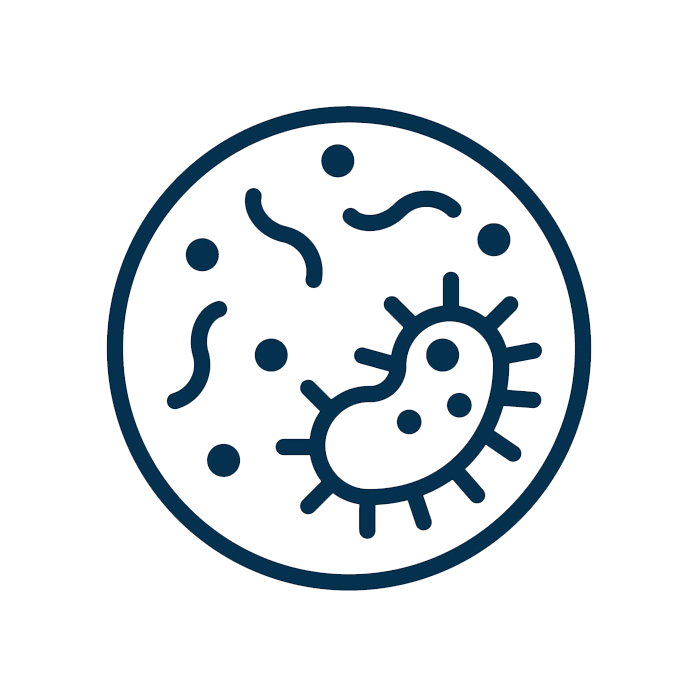Metagenome Sequencing
Microbiomes contain diverse microbial communities whose interactions not only impact the system residents, but also have profound effects on the ecology, chemistry, and health of their shared host or environment. Capturing the interactions among microbes is essential as we expand our understanding of host-microbe dynamics, evaluate environmental degradation or remediation, and develop post-antibiotic-era therapies. Current insights in these fields are driven by genomic data which can classify taxa, report the abundances of metabolic pathways in a system, and define the microbial community structures that may differentiate health and disease states.
At SeqCenter, we aim to facilitate this research through our 16S/ITS amplicon services and our shotgun metagenomics services.

Shotgun Metagenomics
We strongly encourage you to consult individual service pages for full details of the 16S/ITS amplicon sequencing services and the shotgun metagenomic services. Additionally, below is a brief comparison of the two approaches and a listing of example projects for various community types as a launch point for considering your options.
Comparison of 16S Amplicon and Shotgun Metagenomic Approaches
| 16S/ITS | Shotgun Metagenomics | |
| Requirements |
|
|
| Uses |
|
|
| Strengths |
|
|
| Weaknesses |
|
|
| Methods |
|
|
| Data Received |
|
|
Example Projects
The table below provides example projects, their applications, and potential limitations of each technology, which may serve as a guide when selecting a service appropriate for your project. Please note that applications listed are only recommendations. Always consult the most current literature in your field to determine an appropriate experimental design.
| Community Description | Recommended Approach | Recommended Depth | Rationale |
| Stool | 16S/ITS | 100k reads | Since there is a high amount of diversity in this sample, we want many reads to ensure good coverage. The presence of host genomic material makes stool samples a poor candidate for shotgun metagenomics without a depletion step. Stool samples and stool pathogens are well represented in curated 16S/ITS databases. |
| Environmental swab (dry) | 16S/ITS | 20k-50k reads | Dry swabs may not collect many microbes depending on the surface tested. Surfaces like cell phones, doorknobs, and public access tactile items are good candidates for dry swabs. |
| Environmental swab (wet) | 16S/ITS or Shotgun Metagenomics | 20k-50k reads or the small metagenome package | Exogenous viruses are easily captured from wet swabs but will be missed in 16S analyses. The addition of water also allows more microbes to be collected from a surface. |
| Saliva | 16S/ITS or Shotgun Metagenomics | 50k-100k reads or the small metagenome package | Saliva may encounter the same issues as a stool sample where high amounts of host DNA are carried through metagenomic preps. However, since the oral microbiome is not as well characterized as the gut microbiome, it presents as a good candidate for metagenomic sequencing if sequenced to a high enough depth. |
| Water (low biomass) | 16S/ITS | 20k reads | With a low biomass, it is unlikely that a metagenome will assemble very well and may instead generate small noncontiguous sequenced fragments. |
| Water (high biomass) | Shotgun Metagenomics | Medium metagenome package | High volumes of water can be passed through a two-micron filter to capture cells and enter extraction. These types of samples are good candidates for metagenomic sequencing as they likely contain organisms not previously described. The data may also present an opportunity to look for specific gene sets like bioremediatory metabolic pathways. |
| Clay/Soil | 16S/ITS or Shotgun Metagenomics | 50k-100k reads or the medium or large metagenome packages | Soil is a commonly sequenced microbial sample. If looking for plant pathogens, chemical degrading microbes or gene set, or attempting to discern microbial-fungal interactions, shotgun metagenomics may be most appropriate.
If comparing taxa at different sampling sites, 16S or ITS may be a suitable approach. |

Contact:
91 43rd Street, Ste. 250
Pittsburgh, PA 15201
(878) 227-4915
Services:
About:
Resources:
